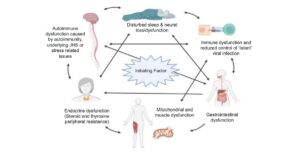The Impact of Heat and Cold on Lymphedema Symptoms
Definition of Lymphedema
Lymphedema is a chronic condition that occurs when excess lymphatic fluid builds up in tissues, causing swelling. This happens when the lymphatic system, responsible for maintaining fluid balance and immune function, is compromised. Lymphedema can occur due to damage or removal of lymph nodes, often related to breast cancer treatment or other cancer therapies. There are two main types: primary lymphedema, which is hereditary, and secondary lymphedema, caused by injury, surgery, or radiation.
Overview of Symptoms Associated with Lymphedema
Symptoms of lymphedema include swelling in the arms, legs, or other extremities, a feeling of heaviness or tightness, restricted range of motion, and recurring infections. Skin changes, such as thickening or hardening, are also common. The severity of symptoms can range from mild discomfort to severe lymphedema that significantly impacts daily life. Early diagnosis and prompt treatment of lymphedema are crucial to preventing complications and worsening lymphedema.
Importance of Understanding Environmental Factors, Specifically Heat and Cold, on Lymphedema
Environmental factors, particularly heat and cold, can significantly impact the management of lymphedema. Heat can increase swelling by dilating blood vessels, while cold can help reduce inflammation and promote lymph drainage. However, both extremes require careful management to avoid complications. Understanding how temperature affects lymphatic flow and knowing the appropriate treatments can improve the quality of life for people with lymphedema.
The Effects of Heat on Lymphedema Symptoms
Physiological Response to Heat
When exposed to heat, the body’s blood vessels dilate in a process known as vasodilation. This increases blood flow and can cause lymphatic fluid to accumulate in tissues, worsening lymphedema symptoms. Heat can also affect lymph nodes and lymphatic vessels, reducing their ability to improve drainage and maintain fluid balance. For patients with lymphedema, this physiological response can exacerbate swelling, leading to increased discomfort.
How Heat Can Exacerbate Swelling and Discomfort
Heat can increase swelling and discomfort by causing fluid to pool in areas affected by lymphedema. This is particularly problematic for individuals with arm lymphedema or leg lymphedema, as heat can impair the already compromised lymphatic flow. The combination of heat and impaired lymphatic drainage can lead to inflammation, skin tightness, and a sensation of heaviness. Activities like hot showers, saunas, or direct sun exposure can worsen these symptoms. Studies from Johns Hopkins Medicine and the National Lymphedema Network highlight that prolonged exposure to heat can increase the risk of developing lymphedema or worsen existing cases.
Recommendations for Managing Symptoms in Hot Conditions
- Stay Cool: Avoid prolonged exposure to heat by staying in air-conditioned environments and wearing lightweight, breathable clothing.
- Use Compression Garments: Wearing compression garments, such as compression sleeves or elastic bandages, can help prevent swelling. Ensure that these garments are breathable to prevent overheating.
- Stay Hydrated: Proper hydration helps maintain fluid balance, reducing the risk of swelling.
- Limit Heat Exposure: Avoid hot tubs, saunas, and long hot showers, which can increase swelling.
The Effects of Cold on Lymphedema Symptoms
Physiological Response to Cold
Cold exposure causes blood vessels to constrict, a process known as vasoconstriction. This reduces blood flow, which can help decrease inflammation and swelling. For individuals with lymphedema, this response can temporarily relieve symptoms by reducing fluid buildup in tissues. Cold therapy, such as ice packs or cold compresses, can also numb areas affected by lymphedema, providing pain relief.
Potential Benefits of Cold Therapy for Lymphedema
Cold therapy can offer several benefits for managing lymphedema symptoms:
- Reduces Inflammation: Cold therapy decreases inflammation, which can help alleviate swelling and discomfort.
- Improves Lymph Drainage: The constriction of blood vessels can promote better lymphatic flow, improving drainage of lymphatic fluid.
- Provides Pain Relief: Cold treatments can numb areas of swelling, reducing pain and discomfort associated with lymphedema.
Guidelines for the Safe Application of Cold Treatments
- Use Cold Therapy in Moderation: Limit cold treatments to 15-20 minutes at a time to avoid skin damage.
- Avoid Direct Contact: Place a cloth or towel between ice packs and the skin to prevent frostbite.
- Monitor Skin Sensation: Individuals with reduced sensation should be cautious when using cold therapy to avoid injury.
- Consult a Lymphedema Therapist: Always seek guidance from a healthcare professional before using cold therapy as part of a lymphedema treatment plan.
Practical Strategies for Managing Temperature Effects
Lifestyle Adjustments to Mitigate Heat and Cold Impacts
Managing lymphedema involves making lifestyle adjustments to minimize the effects of heat and cold. For example:
- In Hot Weather: Stay indoors during peak heat, use fans or air conditioning, and avoid prolonged sun exposure.
- In Cold Weather: Dress in layers to stay warm, but avoid overly tight clothing that can restrict lymphatic flow.
Importance of Hydration and Skin Care
- Hydration: Staying hydrated is essential for maintaining lymphatic fluid balance. Drinking plenty of water helps prevent fluid retention and supports lymph drainage.
- Skin Care: Proper skin care prevents complications such as infections and skin thickening. Moisturize regularly to keep the skin supple and avoid cuts or abrasions that could lead to infections.
Role of Compression Garments in Temperature Regulation
Compression garments, such as compression sleeves and elastic bandages, play a crucial role in managing lymphedema by promoting lymphatic flow and preventing fluid buildup. They also help regulate temperature by providing insulation in cold weather and preventing excessive swelling in heat. When selecting compression garments, choose breathable fabrics that allow moisture to escape, reducing the risk of overheating.
Conclusion
Recap of the Influence of Heat and Cold on Lymphedema Symptoms
Heat and cold have distinct effects on lymphedema symptoms. Heat can exacerbate swelling and discomfort by increasing fluid retention, while cold can reduce inflammation and improve drainage. Understanding these effects is essential for effective lymphedema management.
Emphasis on Individualized Management Strategies
Lymphedema management should be tailored to each individual’s needs. Factors such as the severity of symptoms, lifestyle, and personal tolerance to heat and cold should guide treatment choices. Manual lymphatic drainage, compression therapy, and other treatments should be customized to ensure optimal results.
Encouragement for Ongoing Research and Awareness in Lymphedema Care
Ongoing research into the effects of heat and cold on lymphedema is essential to improve treatment options and enhance quality of life for patients. Organizations like the National Lymphedema Network and Johns Hopkins Medicine are leading efforts to increase awareness and develop innovative treatments. By staying informed and proactive, individuals living with lymphedema can better manage their symptoms and enjoy a higher quality of life.
FAQs
Q: How does temperature affect the symptoms of lymphedema?
A: Temperature can significantly influence the symptoms of lymphedema. Heat can cause swelling to increase due to expanded blood vessels, which may exacerbate the symptoms of lymphedema. Conversely, cold can help reduce inflammation and swelling, providing relief for those managing lymphedema symptoms.
Q: What are the common causes of lymphedema?
A: Lymphedema can occur due to various reasons, including damage to the lymphatic system from surgery, radiation therapy after breast cancer, infections, or trauma. The risk of lymphedema increases if lymph nodes are removed or damaged during treatment for lymphedema.
Q: What treatment options are available for lymphedema?
A: Treatment for lymphedema often includes a combination of therapies such as compression garments, manual lymph drainage, pneumatic compression devices, and exercise. Surgical treatment options, including lymph node transfer, may also be considered for severe cases.
Q: How can individuals manage lymphedema symptoms at home?
A: Managing lymphedema at home can involve several strategies, including wearing compression garments, keeping the affected limb elevated, practicing gentle exercises, and applying cold packs to reduce swelling. It is also essential to maintain a healthy diet and stay hydrated.
Q: What are the stages of lymphedema, and how can they impact treatment?
A: Lymphedema is classified into several stages, ranging from mild swelling in the initial stage to severe swelling and skin changes in later stages. Early diagnosis and treatment of lymphedema are crucial, as early stages can often be managed more effectively with less invasive methods.
Q: Can lymphedema occur after breast cancer treatment?
A: Yes, lymphedema after breast cancer is a common concern, especially if lymph nodes were removed or damaged during surgery. It may develop shortly after treatment or even years later, making ongoing monitoring and preventative measures for lymphedema essential.
Q: What preventative measures can help reduce the risk of lymphedema?
A: Preventative measures for lymphedema include maintaining a healthy weight, avoiding infections, protecting the affected limb from injury, and engaging in regular physical activity. Additionally, individuals should follow their healthcare provider’s guidelines after surgery or treatment.
Q: What tests are used for the diagnosis of lymphedema?
A: Diagnosis of lymphedema typically involves a physical examination and may include imaging tests such as ultrasound or MRI to assess the lymphatic system. These tests can help determine the extent of lymphedema and guide treatment options.
Q: How does managing lymphedema change over time?
A: The management of lymphedema may evolve based on the individual’s symptoms and stage of the condition. As lymphedema progresses, more intensive treatment options, including mechanical lymph drainage accompanied by compression therapy, may become necessary to prevent lymphedema from getting worse.





